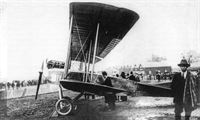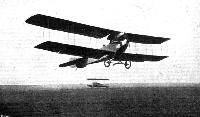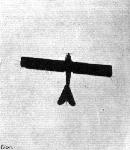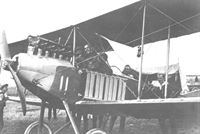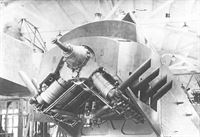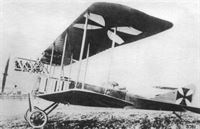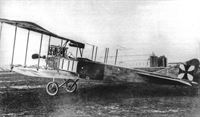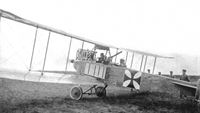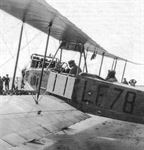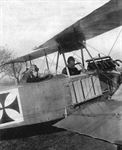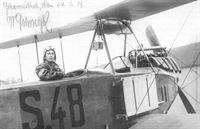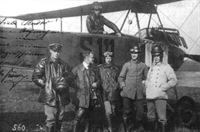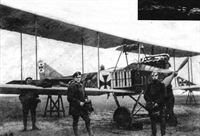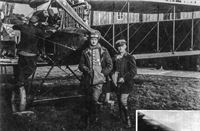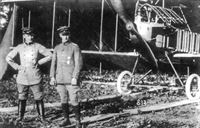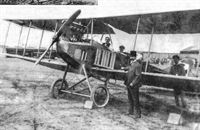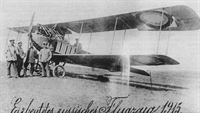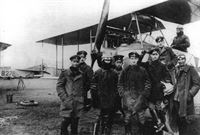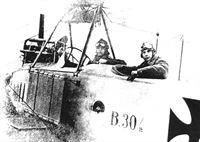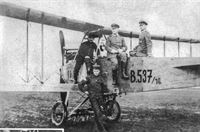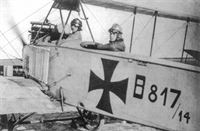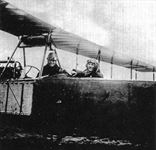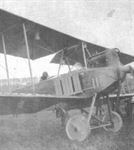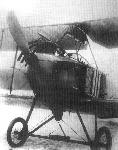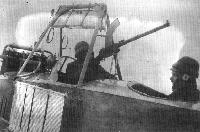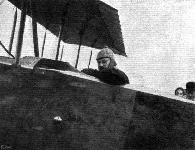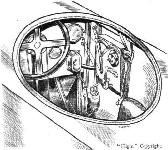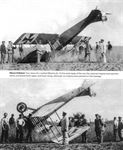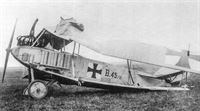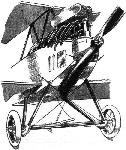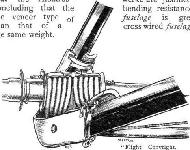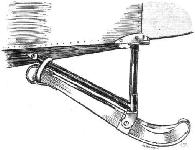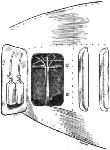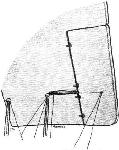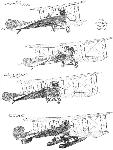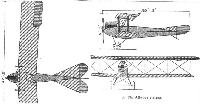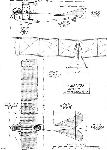
Описание
Страна: Германия
Год: 1913
.Two-seat reconnaissance and training duties
Варианты
- Albatros - B.I - 1913 - Германия
- Albatros - WDD / W.1 - 1913 - Германия
- Albatros - B.II - 1914 - Германия
- Albatros - B.III - 1915 - Германия
- Лебедев - Лебедь-XI - 1915 - Россия
- Albatros - C.III - 1916 - Германия
- Albatros - C.IV - 1916 - Германия
- Albatros - C.VI - 1916 - Германия
- Albatros - W.2 - 1916 - Германия
- Лебедев - Лебедь-XII - 1916 - Россия
- Лебедев - ЛМ-1 / Лебедь Морской - 1916 - Россия
- В.Кондратьев Самолеты первой мировой войны
- А.Александров, Г.Петров Крылатые пленники России
- O.Thetford, P.Gray German Aircraft of the First World War (Putnam)
- J.Herris Albatros Aircraft of WWI. Vol 1: Early Two-Seaters (A Centennial Perspective on Great War Airplanes 24)
- M.Dusing German Aviation Industry in WWI. Volume 1 (A Centennial Perspective on Great War Airplanes 84)
- M.Schmeelke "Torpedo Los!" (Aeronaut)
- P.Grosz, G.Haddow, P.Shiemer Austro-Hungarian Army Aircraft of World War One (Flying Machines)
- E.Hauke, W.Schroeder, B.Totschinger Die Flugzeuge der k.u.k. Luftfahrtruppe und Seeflieger 1914-1918
- Журнал Flight
-
J.Herris - Albatros Aircraft of WWI. Volume 1: Early Two-Seaters /Centennial Perspective/ (24)
Albatros B.I B.241/13 assigned to Feld-Flieger Abteilung 19. This early aircraft had national insignia on upper and lower surfaces of the lower wing and none on the upper wing. The rudder cross has a crown, the letter 'W', and the date '1914' superimposed on it, a literal interpretation of the Iron Cross medal.
-
J.Herris - Albatros Aircraft of WWI. Volume 1: Early Two-Seaters /Centennial Perspective/ (24)
Albatros B.27/14 carried the pre-war marking of a black stripe under each lower wing. This aircraft was later designated a B.I
-
M.Bowden - The Great War's Finest. Volume1: Western Front 1914 /Aeronaut/ (1)
Albatros B.I B.30/14 flown by Dietze and Rosenmuller of Feld-Flieger-Abteilung 24
-
J.Herris - Albatros Aircraft of WWI. Volume 1: Early Two-Seaters /Centennial Perspective/ (24)
Albatros B.I of an unknown unit on the Easter Front, 1915. This aircraft had the enlarged vertical tail and decorated wheel covers.
-
J.Herris - Albatros Aircraft of WWI. Volume 1: Early Two-Seaters /Centennial Perspective/ (24)
Albatros B.I Hindenberg was named in honor of the hero of the Battle of Tannenburg. Assigned to Feld-Flieger Abteilung 2, it was flown by Wunderlich and Oblt. Schulz.
-
J.Herris - Albatros Aircraft of WWI. Volume 1: Early Two-Seaters /Centennial Perspective/ (24)
Albatros B.I WEDDIGEN was named in honor of the captain of U-9, Otto Weddigen, who sank the RN cruisers Cressy, Aboukir, and Hogue on 22 September 1914. It was assigned to Feld-Flieger Abteilung 2.
-
J.Herris - Albatros Aircraft of WWI. Volume 1: Early Two-Seaters /Centennial Perspective/ (24)
This Albatros B.I was armed with a flexible Parabellum machine gun for the observer in the front cockpit. The dark wheel cover is shown as red but may be another dark color other than black. This aircraft, from an unidentified unit, was active in 1915.
-
J.Herris - Albatros Aircraft of WWI. Volume 1: Early Two-Seaters /Centennial Perspective/ (24)
Albatros B.I S.69 is shown here after modification for torpedo carrying trials by the German Navy.
-
M.Schmeelke - "Torpedo Los!" /Aeronaut/
Albatros B.I S.69 is shown here after modification for torpedo carrying trials by the German Navy.
-
J.Herris - Albatros Aircraft of WWI. Volume 1: Early Two-Seaters /Centennial Perspective/ (24)
Albatros B.I in IRAS markings after capture by the Russians. This aircraft was photographed after being re-captured by the Germans in 1915.
-
J.Herris - Albatros Aircraft of WWI. Volume 1: Early Two-Seaters /Centennial Perspective/ (24)
Albatros B.I LA 12 of the Netherlands Air Service in 1915. Prior to internment it was B.521/14 in German army service.
-
J.Herris - Albatros Aircraft of WWI. Volume 1: Early Two-Seaters /Centennial Perspective/ (24)
Albatros B.I 21.28 of the k.u.k. Luftfahrtruppe assigned to Flik 8 and written off there on 27 April 1915. It was formerly B.87/14 in German service before purchase by Austria-Hungary.
-
J.Herris - Albatros Aircraft of WWI. Volume 1: Early Two-Seaters /Centennial Perspective/ (24)
This Albatros DD was photographed in December 1913 at Johannisthal, location of the main Albatros factory. It was powered by a 100 hp Mercedes and had a Windhoff radiator above the engine. Its strut bracing was much simpler than earlier Albatros biplanes. It has the early, low profile fin and rudder. (Peter M. Bowers Collection/The Museum of Flight)
-
J.Herris - Albatros Aircraft of WWI. Volume 1: Early Two-Seaters /Centennial Perspective/ (24)
Albatros DD flown by designer Thelen on a sales tour to the UK at Hendon. It survived in British service into 1918.
-
J.Herris - Albatros Aircraft of WWI. Volume 1: Early Two-Seaters /Centennial Perspective/ (24)
Mercedes-powered Albatros DD with the early low-profile fin and rudder at a pre-war aviation meet.
-
J.Herris - Albatros Aircraft of WWI. Volume 1: Early Two-Seaters /Centennial Perspective/ (24)
This Mercedes-powered Albatros B.I was used pre-war for flight training.
-
Журнал - Flight за 1914 г.
The Albatros in flight.
-
Журнал - Flight за 1914 г.
View from below of the Albatros in flight.
-
J.Herris - Albatros Aircraft of WWI. Volume 1: Early Two-Seaters /Centennial Perspective/ (24)
The Albatros DD became the B.I. Shown here with a 100 hp Mercedes, when powered by a 75 hp Mercedes this aircraft was used by Landmann and Boehm to break the world flight duration record in May and again in July 1914.
The Albatros B.I was the third of the three most numerous B-types used early in the war. Its long-span, three-bay wings are distinctive. -
M.Dusing - German Aviation Industry in WWI. Volume 1 /Centennial Perspective/ (84)
Werner Landmann set a new endurance world record with his Albatros biplane with 21 hours 49 minutes and a world distance flight record of 1,900 km.
-
J.Herris - Albatros Aircraft of WWI. Volume 1: Early Two-Seaters /Centennial Perspective/ (24)
Albatros DD surrounded by troops, probably pre-war.
-
J.Herris - Albatros Aircraft of WWI. Volume 1: Early Two-Seaters /Centennial Perspective/ (24)
Albatros DD (B.I) fitted with 140 hp Hiero at the International Flugmeeting in Aspern where pilot Ernst von Lossl used it to set two world records; 4,240 m with two passengers and 4,770 m with three passengers, both on 27 June 1914. No national insignia were applied to this pre-war aircraft.
-
P.Grosz, G.Haddow, P.Shiemer - Austro-Hungarian Army Aircraft of World War One /Flying Machines/
Until beaten by Bier flying a Lloyd biplane (40.01), Ernst von Lossl set a world record at the Third International Flugmeeting with three passengers (jammed in the front seat) flying the German Albatros biplane (competition No. 17 - 140 hp Hiero engine). It is likely this aircraft was taken over by the air service when the war started.
-
P.Grosz, G.Haddow, P.Shiemer - Austro-Hungarian Army Aircraft of World War One /Flying Machines/
This Phonix-built Albatros B.I, powered by a 145 hp Hiero engine, was test flown by Leo Roth at Aspern in late 1914. Although no proof exists, it may have been the first form of the 20.01, or possibly an Albatros B.I(Ph) series 23 production airframe experimentally fitted with three-bay wings.
-
P.Grosz, G.Haddow, P.Shiemer - Austro-Hungarian Army Aircraft of World War One /Flying Machines/
The Phonix 20.01 prototype with a 150 hp Daimler engine photographed at the Heeresgeschichtliches Museum. An identification plate on the lower wing inscribed "Albatros Typ ODD Nr.I, Berlin-Johannisthal” could signify that the wings were replacement ones manufactured by the German Albatros company.
-
P.Grosz, G.Haddow, P.Shiemer - Austro-Hungarian Army Aircraft of World War One /Flying Machines/
Other than this photograph of the 200 hp Hiero inverted V-8 engine installed in the Phonix 20.02 prototype, no photographs of the prototype have been found. The outer fuselage of the Phonix 20.11 bomber, that was never completed, is in the left background.
Другие самолёты на фотографии: Phonix 20.10 / 20.11 / 20.12 - Австро-Венгрия - 1916
-
A.Olejko - Habsburg Wings 1915 /Aeronaut/
In the fall of 1914, Albatros B.I planes were delivered to the field Fliegerkompanien by the German ally... The photo shows the Albatros B.I No. 28 aircraft from Flik 5 in front of the hangar with ground service - source: Fotoarchiv SAW-KA.
Flik 5 ground crew prepare to lift the three-bay Albatros Alb.28 (later B.I 21.28) for sideways storage on the Petrikau (Piotrkow, Poland) airfield. -
P.Grosz, G.Haddow, P.Shiemer - Austro-Hungarian Army Aircraft of World War One /Flying Machines/
A demonstration of the confusion arising from aircraft number changes. In the foreground is a three-bay Albatros B.I 21.30 (ex 22.30). It served with Flik 1 until damaged by fire in June 1915. According to a Flars directive it was designated 21.22 (neu) in June 1916. In the distance is an Albatros B.I with the original (three-bay) designation 22.29, soon changed to 21.29.
-
J.Herris - Albatros Aircraft of WWI. Volume 1: Early Two-Seaters /Centennial Perspective/ (24)
Photographed at the Albatros factory, this is thought to be the first Albatros B.I fitted with the 150 hp Benz Bz.III; its fuselage was lengthened to balance the heavier engine.
-
J.Herris - Albatros Aircraft of WWI. Volume 1: Early Two-Seaters /Centennial Perspective/ (24)
The Albatros B.I was powered by a variety of engines using drag-producing side radiators. Larger vertical tail surfaces improved the aircraft's in-flight stability and were adopted for most production B.I aircraft.
-
J.Herris - Albatros Aircraft of WWI. Volume 1: Early Two-Seaters /Centennial Perspective/ (24)
Albatros B.820/14 in the field with the later fin and rudder. The rudder appears to have been recently recovered.
-
J.Herris - Albatros Aircraft of WWI. Volume 1: Early Two-Seaters /Centennial Perspective/ (24)
This Benz-powered Albatros B.I has been modified to carry a flexible, defensive machine gun for the observer, who still occupies the front seat, restricting his field of fire. At this stage a national insignia is on the fuselage and the redundant insignia beneath the upper wing and above the lower wing have been eliminated. The attachment of the forward cabane strut of Benz-powered B.I aircraft was farther forward on the nose than that of Mercedes-powered aircraft like the example below.
-
J.Herris - Albatros Aircraft of WWI. Volume 1: Early Two-Seaters /Centennial Perspective/ (24)
Mercedes-powered Albatros B.I L.F.78(W.Nr. 494) arrived on 20 September 1915, was with the II Marine Feldflieger Abteilung (II MFFA) on 29 October 1916, and was written off on 17 November 1917. The aircraft appears to be named Grossmuller.
-
J.Herris - Albatros Aircraft of WWI. Volume 1: Early Two-Seaters /Centennial Perspective/ (24)
Mercedes-powered Albatros B.I piloted by Hptm. Eberhard von der Decken of FFA 61.
-
J.Herris - Albatros Aircraft of WWI. Volume 1: Early Two-Seaters /Centennial Perspective/ (24)
Mercedes-powered Albatros B.I S.48 trainer in naval service ("S" for Schulflugzeug = trainer). Its works number was 474. The airframe was accepted by the Freiwilliges Marine Fliegerkorps (FMF, or volunteer navy flying corps) on 27 November 1914, and the engine (a Mercedes D.I) was accepted on 4 December 1914. The photo was apparently taken just 20 days later on 24 December 1914 at Johannisthal.
-
J.Herris - Albatros Aircraft of WWI. Volume 1: Early Two-Seaters /Centennial Perspective/ (24)
Albatros B.I S.111 was flown by the volunteer Marine Fliegertruppe; it was W.Nr.473 accepted 16 February 1915.
-
J.Herris - Albatros Aircraft of WWI. Volume 1: Early Two-Seaters /Centennial Perspective/ (24)
Mercedes-powered Albatros B.I(OAW) photographed on the Eastern Front in Poland and issued as a Sanke card.
-
J.Herris - Albatros Aircraft of WWI. Volume 1: Early Two-Seaters /Centennial Perspective/ (24)
Unusually, this Mercedes-powered Albatros B.I carries its national insignia far forward on the fuselage. The rudder insignia is much smaller than that on the aircraft in the background.
-
J.Herris - Albatros Aircraft of WWI. Volume 1: Early Two-Seaters /Centennial Perspective/ (24)
This Benz-powered Albatros B.I of Feld-Flieger Abteilung 23 at Roupy in 1916 was flown by pilot Vzfw. Josef Veltjens and observer Lt. von Ziegesar. Veltjens later became a successful fighter pilot, scoring 33 confirmed victories, being promoted to Leutnant, and being awarded the Pour le Merite. He flew Albatros, Fokker, and SSW fighters during his career and survived the war. Ziegesar became a fighter pilot as well, and served alongside Veltjens (and Berthold) in Jastas 14, then 18 and finally 15. He scored three confirmed victories and was even acting CO of Jasta 15 from 12 August to 18 August 1918. He also flew the Fokker D.VII and SSW D.III.
-
J.Herris - Albatros Aircraft of WWI. Volume 1: Early Two-Seaters /Centennial Perspective/ (24)
Albatros B.I of Feld-Flieger Abteilung 25 with its crew of Leutnants Hermann Goring (at left) and Bruno Loerzer. Both men later transferred to fighters and became noted aces, each winning the Pour le Merite and surviving the war, Goring with 22 victories and Loerzer with 44. Goring later became notorious for his role in the Third Reich. A Benz engine provided the power.
-
J.Herris - Albatros Aircraft of WWI. Volume 1: Early Two-Seaters /Centennial Perspective/ (24)
Unidentified Albatros B.I. The civilian dress of at least two of men, the insignia on the tail, and the hangars in the background indicate a wartime flight school.
-
J.Herris - Albatros Aircraft of WWI. Volume 1: Early Two-Seaters /Centennial Perspective/ (24)
Benz-powered Albatros B.l captured by the Russians and recaptured by the Germans.
-
J.Herris - Albatros Aircraft of WWI. Volume 1: Early Two-Seaters /Centennial Perspective/ (24)
Mercedes-powered Albatros B.I trainer; instructor August Quoos in cockpit with students in front.
-
J.Herris - Albatros Aircraft of WWI. Volume 1: Early Two-Seaters /Centennial Perspective/ (24)
Mercedes-powered B.I B.30/14 and its crew sit for a portrait.
-
J.Herris - Albatros Aircraft of WWI. Volume 1: Early Two-Seaters /Centennial Perspective/ (24)
Mercedes-powered Albatros B.I B.537/14 carries a bomb-dropping device under its fuselage. The men are apparently the air crew and ground crew.
-
J.Herris - Albatros Aircraft of WWI. Volume 1: Early Two-Seaters /Centennial Perspective/ (24)
Mercedes-powered Albatros B.I 817/14 ready for another training flight with August Quoos as instructor pilot (in back cockpit) and Lt. Kumme as the flight student at the Military flying school at Hundsfeld.
-
J.Herris - Albatros Aircraft of WWI. Volume 1: Early Two-Seaters /Centennial Perspective/ (24)
This Mercedes-powered Albatros B.I was piloted by Lt. Busso von Bulow; Lt. Gerhard Nette in the front seat was the observer.
-
J.Herris - Albatros Aircraft of WWI. Volume 1: Early Two-Seaters /Centennial Perspective/ (24)
Mercedes-powered Albatros B.I ready for take off with the pilot in his cockpit and engine running.
-
M.Schmeelke - "Torpedo Los!" /Aeronaut/
Albatros B.I S.69 was converted to conduct torpedo-dropping trials and is seen here with the small-caliber it was designed to carry. The landing gear was modified to enable the torpedo to be carried. The trials were considered to be unsuccessful and all later WWI German torpedo bombers were floatplanes. (Peter M. Grosz Collection/SDTB)
-
J.Herris - Albatros Aircraft of WWI. Volume 1: Early Two-Seaters /Centennial Perspective/ (24)
Albatros B.I LA12 of the Netherlands air service (formerly B.521/14 in German service) enjoys a day at the beach.
-
Журнал - Flight за 1914 г.
Herr Thelen in the cockpit of the Albatros.
-
Журнал - Flight за 1914 г.
HERR THELEN.
-
Журнал - Flight за 1914 г.
Pilot's cockpit on Albatros.
-
J.Herris - Albatros Aircraft of WWI. Volume 1: Early Two-Seaters /Centennial Perspective/ (24)
Albatros B.I reconnaissance airplane after a bad landing, a common occurrence on the rough, wartime airfields.
-
J.Herris - Albatros Aircraft of WWI. Volume 1: Early Two-Seaters /Centennial Perspective/ (24)
Two views of a crashed Albatros B.I. At this early stage of the war the national insignia were painted above and below both upper and lower wings, although no insignia were painted on the fuselage.
-
J.Herris - Albatros Aircraft of WWI. Volume 1: Early Two-Seaters /Centennial Perspective/ (24)
Lt Just crashed Albatros B.I B.45/15 during training in September 1916. The engine was a 150 hp Benz Bz.III.
-
H.Nowarra, G.Duval - Russian Civil and Military Aircraft 1884-1969
September 8th, 1914 - P.N. Nesterov destroying a German aircraft by ramming; the first recorded instance of this method of attack. (From a contemporary painting.)
Другие самолёты на фотографии: Morane-Saulnier G/H - Франция - 1912
-
M.Bowden - The Great War's Finest. Volume1: Western Front 1914 /Aeronaut/ (1)
Armed with self-loading carbines, German aviators earned their first aerial victory during the First Battle of Ypres. (Author's Collection)
-
Журнал - Flight за 1914 г.
Chassis and engine of Albatros.
-
Журнал - Flight за 1914 г.
Detail of shock absorbing arrangement on Albatros.
-
Журнал - Flight за 1914 г.
Left, method on Albatros of locking propeller on engine shaft; centre, the hand operated brake; and right, attachment of lower plane to fuselage.
-
Журнал - Flight за 1914 г.
Left, the anemometer on the Albatros wfcich is mounted on one of inter-plane struts. Centre, a chassis detail, and right, attachment of inter-plane struts and cress bracing cables to main spars.
-
Журнал - Flight за 1914 г.
The tail skid of Albatros.
-
Журнал - Flight за 1914 г.
Oil and petrol cans mounted on engine inspection door of Albatros.
-
Журнал - Flight за 1914 г.
Aileron crank lever on Albatros.
-
Журнал - Flight за 1915 г.
FUSELAGE ECONOMY. - Four members of the Albatros family, all of which are fitted with the same size fuselage. In this manner three different types of land machines can be provided simply by substituting wings of various sizes, whilst the larger size machine is turned into a seaplane by fitting floats instead of the usual undercarriage.
Другие самолёты на фотографии: Albatros B.II - Германия - 1914Albatros racing biplane - Германия - 1913Albatros WDD / W.1 - Германия - 1913
-
Журнал - Flight за 1914 г.
3. The Albatros biplane.
-
Журнал - Flight за 1914 г.
THE ALBATROS BIPLANE. - Plan, side and front elevations to scale.
В.Кондратьев Самолеты первой мировой войны
АЛЬБАТРОС B-I/B-II/B-III / ALBATROS B-I/B-II/B-III
Весной 1914 года молодой талантливый инженер Эрнст Хейнкель возглавил конструкторское бюро фирмы Альбатрос Флюгцойгверк в Иоханнештале. Под его руководством была разработана серия чрезвычайно удачных многоцелевых двухместных бипланов, получивших наибольшее распространение в немецкой фронтовой авиации на раннем этапе Первой мировой войны.
Все они имели деревянный фюзеляж-полумонокок с работающей фанерной обшивкой и характерную стреловидную форму оперения. На всех стояли однорядные двигатели жидкостного охлаждения с тянущим винтом. Крылья с деревянным каркасом, полотняной обшивкой и межкрыльевыми стойками из стальных труб каплевидного сечения.
Первым появился трехстоечный "Альбатрос" B-I, установивший летом 1914-го несколько авиационных рекордов. Вскоре за ним последовал "Альбатрос" B-II несколько меньших размеров с двухстоечной бипланной коробкой.
Оба типа были приняты на вооружение и выпускались в большом количестве на заводах фирм Альбатрос (включая филиал Остдойч Альбатрос Верк - OAW), Бавариш Флюгцойгверк (BFW), Авиатик, Кондор, Роланд, Меркюр и Линке-Хоффман.
ДВИГАТЕЛЬ
B-I и B-II - "Мерседес", 100 или 120л.с., или "Бенц", 110 л.с. или "Аргус", 120 л.с.
ВООРУЖЕНИЕ
Не предусмотрено.
ЛЕТНО-ТЕХНИЧЕСКИЕ ХАРАКТЕРИСТИКИ
B-I
Размах, м 14,5
Длина, м 8,6
Площадь крыла, кв.м 44,2
Сухой вес, кг 747
Взлетный вес, кг 1080
Скорость максимальная, км/ч 105
Время набора высоты, м/мин 800/10
Описание:
















